
Silphium is a genus of North American plants in the tribe Heliantheae within the family Asteraceae.

Silphium laciniatum is a species of flowering plant in the family Asteraceae known commonly as compassplant or compass plant. It is native to North America, where it occurs in Ontario in Canada and the eastern and central United States as far west as New Mexico. Other common names include prairie compass plant, pilotweed, polarplant, gum weed, cut-leaf silphium, and turpentine plant. It is a rosinweed of genus Silphium.

Echinacea tennesseensis, also known as the Tennessee coneflower or Tennessee purple coneflower, is a flowering plant in the family Asteraceae, endemic to the cedar glades of the central portion of the U.S. state of Tennessee.

Phlox pilosa, the downy phlox or prairie phlox, is an herbaceous plant in the family Polemoniaceae. It is native to eastern North America, where it is found in open areas such as prairies and woodlands.

Silphium asteriscus, commonly called starry rosinweed, is an herbaceous plant in the family Asteraceae. It is native to the eastern United States, from Oklahoma and Texas east to Florida and Pennsylvania. It is a widespread species found in a variety of open habitats, such as prairies and woodlands.
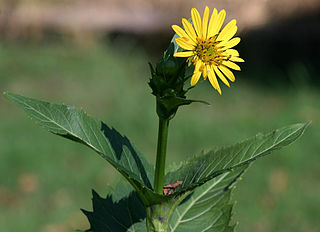
Silphium perfoliatum, the cup plant or cup-plant, is a species of flowering plant in the family Asteraceae, native to eastern and central North America. It is an erect herbaceous perennial with triangular toothed leaves, and daisy-like yellow composite flower heads in summer.
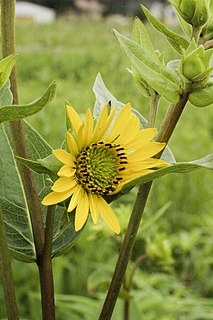
Silphium integrifolium is a species of flowering plant in the family Asteraceae. Its common names include rosinweed, whole-leaf rosinweed, entire-leaf rosinweed, prairie rosinweed, and silflower. It is native to eastern North America, including Ontario in Canada and the eastern and central United States as far west as New Mexico.

Solidago spithamaea is a species of flowering plant in the family Asteraceae known by the common name Blue Ridge goldenrod. It is native to a very small region around the border between North Carolina and Tennessee in the United States. Its three remaining populations are threatened by the loss and degradation of its habitat. It is a federally listed threatened species of the United States.
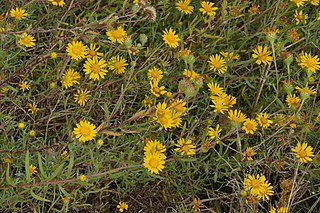
Rayjacksonia aurea is a species of flowering plant in the family Asteraceae known by the common names Houston tansyaster and Houston camphor daisy. It is endemic to Texas in the United States, where it is known only from the Houston area. It is limited to Galveston and Harris Counties.

Silene regia is a species of flowering plant in the family Caryophyllaceae known by the common name royal catchfly. It is native to the central United States. A perennial herb, it grows from a fleshy taproot and has several erect stems growing up to 1.6 meters tall. The leaves are lance-shaped to oval and up to 12 centimeters long, becoming smaller farther up the stem. The inflorescence is an array of many flowers at the top of the stem. The elongate tubular calyx of sepals is up to 2.5 centimeters long and has 10 longitudinal veins. The lobes of the bright red corolla are 1 to 2 centimeters long.

Solidago ptarmicoides, the prairie goldenrod, white flat-top goldenrod or upland white aster, is a North American perennial flowering plant in the family Asteraceae. It is native to the central and eastern Canada and parts of the United States (mostly Great Lakes region, the Northeast, the Ozarks, and the northern Great Plains, with isolated populations in Wyoming, Colorado, Oklahoma, and scattered locations in the Southeast. It has also been called upland white solidago, upland white goldenrod, and sneezewort goldenrod

Nabalus barbatus, the barbed rattlesnakeroot, is a plant in the family Asteraceae. It is native to the Southeastern United States where it is found in small numbers in a few disjunct areas of remaining natural grassland. Because of this, it is considered a globally rare species, with only 35-70 remaining populations. Much of its natural habitat of prairie and savanna has been destroyed. In 2010 it was reclassified from the genus Prenanthes to Nabalus.

Silphium mohrii, known by the common names Mohr's rosinweed and shaggy rosinweed, is a species of flowering plant in the family Asteraceae. It is native to the Southeastern United States, where it is native only to northern Alabama, southern Tennessee, and extreme northwest Georgia. It is native to prairie remnants and rocky limestone openings. Because of its restricted range and severely declined habitat, it is considered a vulnerable species.
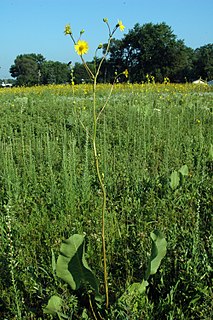
Silphium terebinthinaceum is a member of the Asteraceae, a family that includes sunflowers, commonly referred to as prairie dock or prairie rosinweed. "Rosinweed" became one of the plant's common names due to the fact that upon injury, resin flows from the wound, giving the plant a sweet smell. Tea brewed from the roots of the prairie dock have a variety of medical applications in Native American culture. The smoke from this plant has also been used as a treatment for congestion and rheumatism.

Silphium trifoliatum, commonly known as whorled rosinweed, is a species of flowering plant in the family Asteraceae. It is native to the eastern United States, where it is found east of the Mississippi River. Its natural habitat is open, grassy areas such as prairies, river cobble bars, and roadsides. It is a tall perennial that produces heads of yellow flowers in mid-summer through fall.

Silphium albiflorum, commonly known as white rosinweed, is a species of flowering plant in the family Asteraceae. It is native to the United States, where it is endemic to the state of Texas. Its natural habitat is in open, calcareous prairies.

Silphium radula, commonly known as roughstem rosinweed, is a species of flowering plant in the family Asteraceae. It is native North America, where it is found in the South Central region of the United States. Its natural habitat is prairies over sandy or calcareous soil.
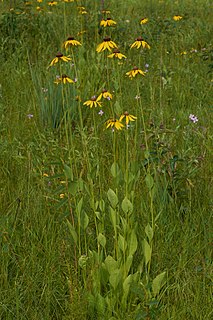
Rudbeckia grandiflora, commonly called rough coneflower, is a species of flowering plant in the family Asteraceae. It is native to North America, where it is found primarily in the south-central United States, including a disjunct population in northwest Georgia. The other populations farther east, all small and isolated, are believed to have originated from human introductions.
Silphium wasiotense, commonly called Appalachian rosinweed, is a species of flowering plant in the family Asteraceae. It is native eastern to North America, where it is endemic to the Cumberland Plateau of Kentucky and Tennessee. Its natural habitat is in dry open woodlands. It is considered rare throughout its range.
Silphium perplexum is a prairie species in the family Asteraceae, it is endemic to the state of Alabama. S. perplexum is commonly known as Old Cahaba rosinweed, a reference to the Cahaba River near which all populations of this species are found.




















